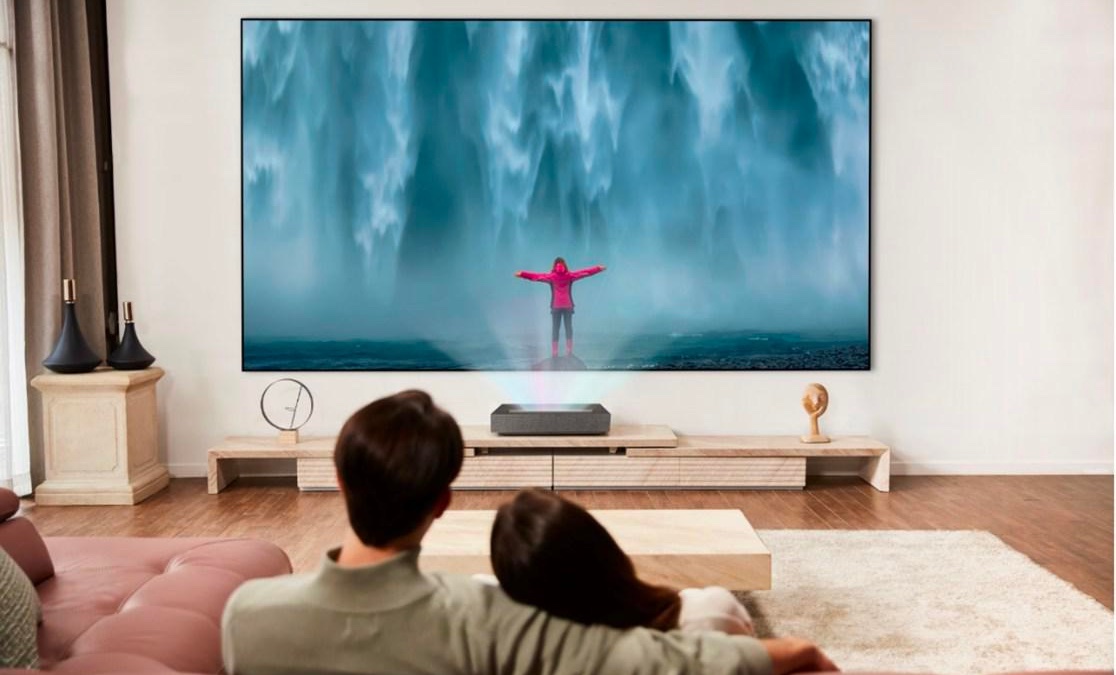
It was easy to get excited about LG’s new lineup of OLED TVs — but it turns out that its new 4K projectors might be more worthy of your attention.
Unveiled in a press release, the flagship LG Cinebeam HU915QE and HU915QB are specc’d to deliver 3,700 and 3,000 lumens of brightness, respectively, which is more than an OLED’s peak brightness if you convert it from nits.
To help that image stay bright and colorful even in direct sunlight, the projectors have LG’s Brightness Optimizer II technology that “automatically adjusts brightness levels to a room’s ambient light conditions” and adaptive contrast.
In addition to being brighter, the two Cinebeam projectors start at a 90-inch projection size from 2.2 inches from the wall and can fill a 120-inch screen from 7.2 inches from the wall. No need to ceiling mount them if you don't have the space.
The bad news? Neither of the projectors are cheap. The brighter of the two, the LG Cinebeam HU915QE, will set you back $6,000 while the dark room-friendly HU915QB goes for $6,500. For comparison, the 65-inch LG C2 OLED costs "only" $2,099.
TVs vs 4K projectors: which one should you buy?

Whenever you compare them side-by-side, 4K projectors are almost always going to be more expensive than their 4K TV counterparts. That simply comes down to the cost of manufacturing — panels are becoming easier and cheaper to produce and the finely tuned components inside a projector haven’t reached the same level of optimization.
Where things get tricky, however, is when you talk about screen sizes larger than, say, 85 inches — that’s where you’ll be spending the same amount of money for a larger OLED or a 4K projector. So which one should you buy?
Sign up to get the BEST of Tom's Guide direct to your inbox.
Get instant access to breaking news, the hottest reviews, great deals and helpful tips.
It used to be the case that if you had a proper home theater room — i.e. a room that you can perfectly control the light to make sure no ambient light seeped in to ruin the contrast — then you’d pick a projector. Otherwise, in a brightly lit room, you’d pick a 4K TV. Now, though, LG’s fighting against the age-old wisdom.
You’ll still want to make your decision about how much space you have in the room and the distance between where you sit and the screen, but with 3,700 lumens of brightness in tow, LG’s new projectors shouldn’t need the absolute pitch-black settings that previous generations of projectors needed.
Looking for a more affordable option? Check out the LG C2 OLED and LG G2 OLED, two of the best OLED TVs to come out so far in 2022.
And if you're on the fence between a projector and big-screen TV, check out our 4K projector vs 4K TV guide to see which one is right for you.

Nick Pino heads up the TV and AV verticals at Tom's Guide and covers everything from OLED TVs to the latest wireless headphones. He was formerly the Senior Editor, TV and AV at TechRadar (Tom's Guide's sister site) and has previously written for GamesRadar, Official Xbox Magazine, PC Gamer and other outlets over the last decade. Not sure which TV you should buy? Drop him an email or tweet him on Twitter and he can help you out.
-
Pete Mitchell The title of the article alone shows you have no clue about OLED. It's not all about peak brightness.Reply -
ChamberLxAI From the perspective of a theater designer and calibration consultant, I have to call this out as total BS.Reply
Please.... If you don't have experience with video or private theaters, at LEAST experience one before buying the latest buzz, but better yet compare what these advertarticles tell you to but side by side with what you really want. No matter your budget.
